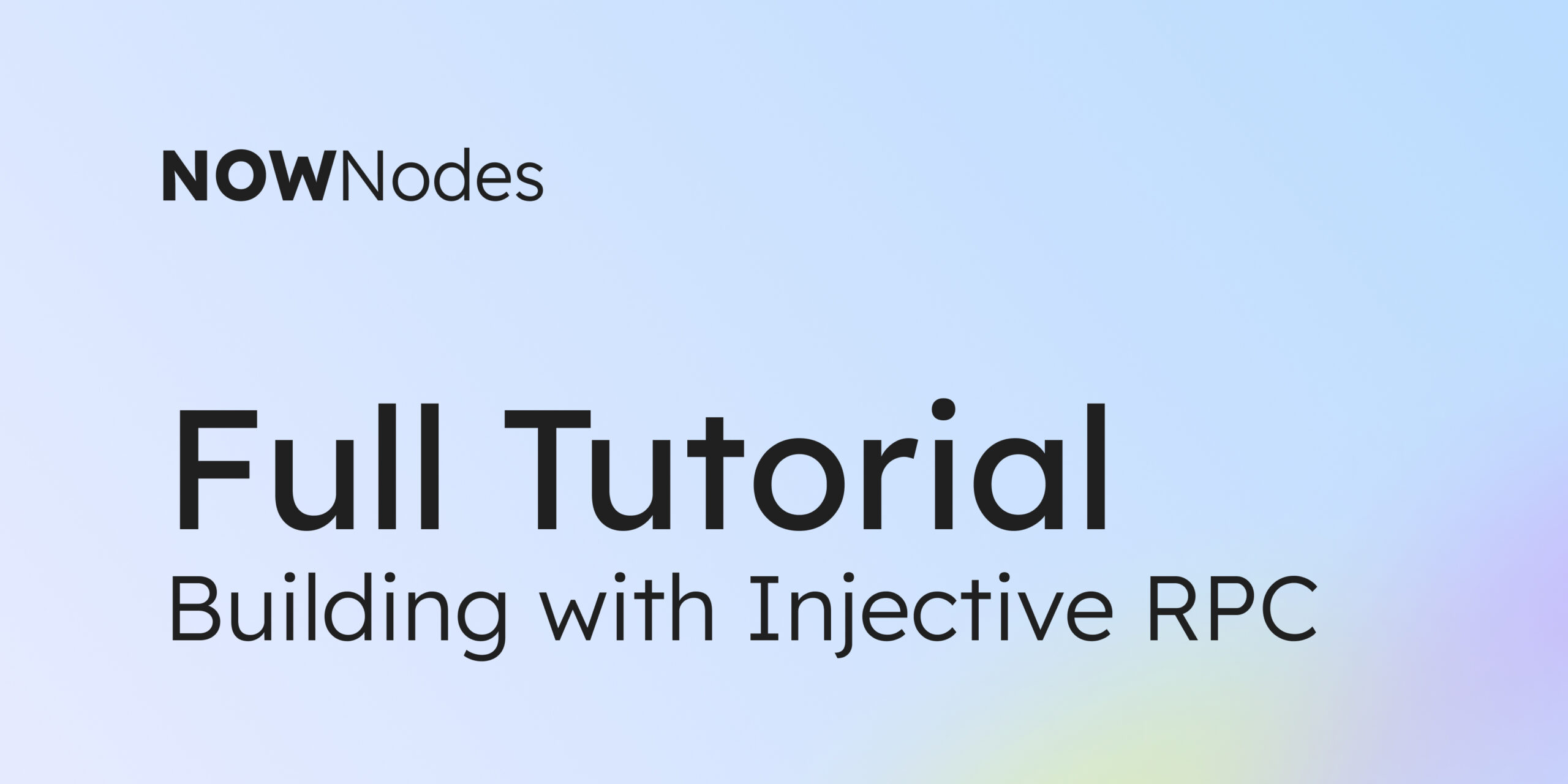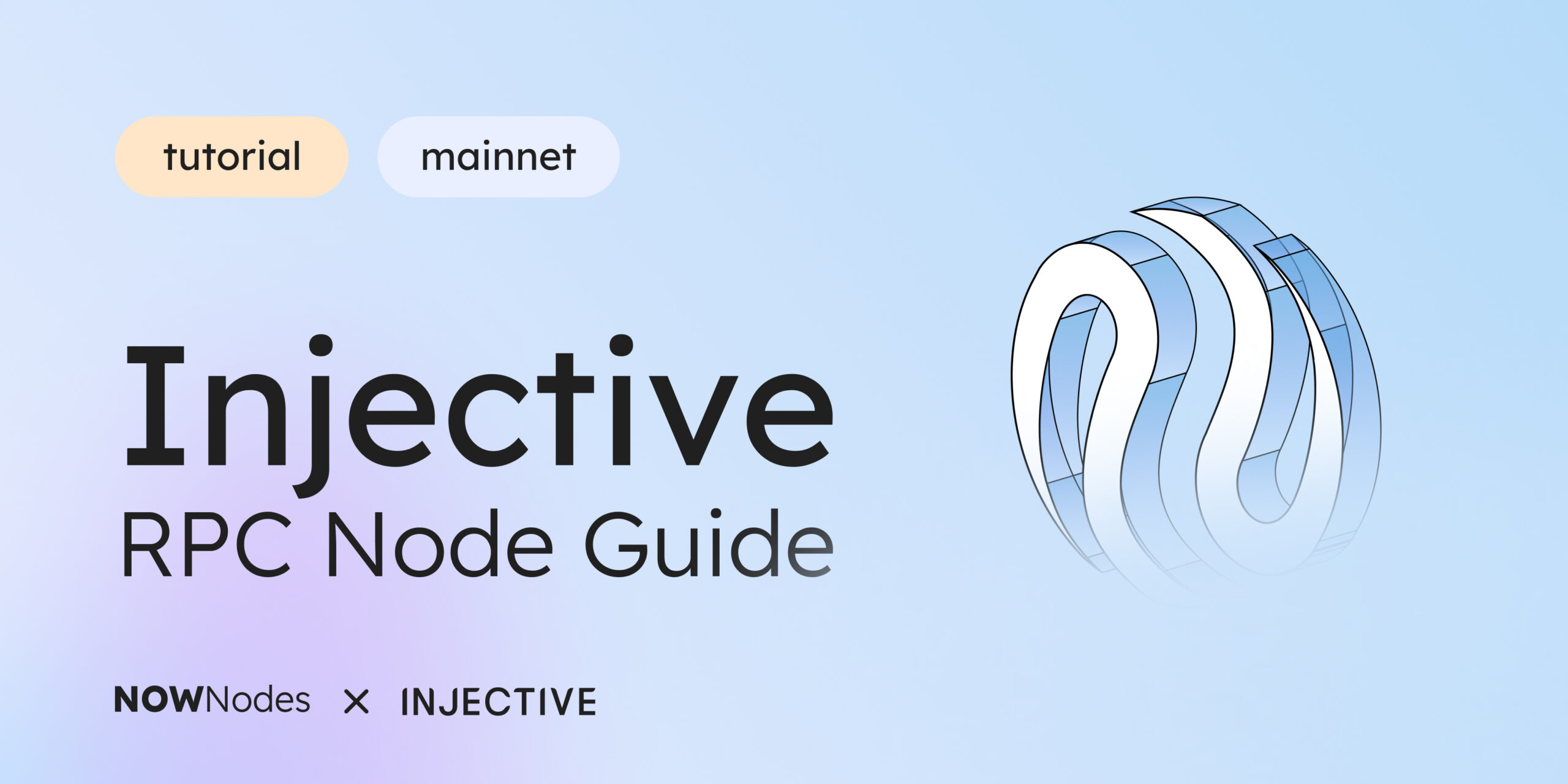Welcome to our new guide! In this tutorial, we are going to provide you with all the required knowledge on how to work with and utilize Injective RPC Full Node. Our article will cover the most popular Injective API methods, ways and interfaces to connect with the Injective network as well as onboard you to start utilizing Injective RPC Node endpoints.
This tutorial was developed by NOWNodes – a web3 nodeOps tooling and node API provider. We support 95+ blockchain networks, including Injective on Mainnet and Testnet, with shared and dedicated access.
Don’t forget to share this article with your developer friends and colleagues 🙂
What is an Injective RPC Node?
First of all, let’s find out what Injective RPC Node is and how it helps builders and crypto enterprises.
An Injective RPC Node is a server that runs the full Injective blockchain software, maintaining a complete and up-to-date copy of the Injective blockchain. It allows for Remote Procedure Calls (RPC), enabling external applications and developers to interact with the Injective blockchain by querying data, submitting transactions, and accessing blockchain services. A lot of developers and businesses actively integrate Injective RPC Nodes for several reasons.
The Injective node instance is used for the development of decentralized applications (dApps), smart contracts, and DeFi tools on Injective. These servers offer a reliable and efficient way to interact with the Injective blockchain, facilitating features like real-time data fetching, transaction processing, and secure communication with the blockchain network. For example, when you refresh the page of balances or send an Injective transaction, the backend of your decentralized application makes calls to the Injective node to either verify or perform the activity.
How to Interact with the Injective RPC Nodes?
There are several interfaces that allow developers and enthusiasts to work with Injective nodes. It’s important to highlight that the core developers of the Injective blockchain initially chose Cosmos SDK to build the network. This means that Injective uses a Tendermint-based Proof-of-Stake (PoS) consensus mechanism and has familiar interfaces and endpoints to interact with the nodes.
Injective LCD (Light Client Daemon):
The LCD interface for Injective blockchain provides a more lightweight and simplified way to interact with the network. It’s designed for developers and enterprises that don’t need the full historical data from the network. For example, our LCD endpoint inj.nownodes.io provides RESTful API, which is particularly useful for web services and applications that need to interact with the blockchain for sending transactions, browsing on-chain data, etc.
Injective RPC (gRPC Remote Procedure Calls):
The gRPC interface is a modern, high-performance framework that is used for server-to-server API calls, as well as known for its efficiency and speed. In the context of Injective blockchain, a gRPC endpoint allows builders to interact with the Injective RPC nodes using these protocols. This is useful for companies and enthusiasts who need a robust and efficient way to query data, submit transactions, and perform other blockchain operations programmatically.
Injective Tendermint:
Tendermint refers to the consensus engine used by the Injective blockchain. An Injective Tendermint endpoint exposes an RPC interface for low-level interactions with the consensus layer of the blockchain. This can include querying block data, transaction data, consensus state, and more. At NOWNodes Injective tendermint endpoint (inj-tendermint.nownodes.io) is used for detailed information about the blockchain’s state and operation, especially for the consensus and validators data.

How to Use Injective RPC Nodes Endpoints? A Full Tutorial
In order to utilize Injective blockchain API endpoints and obtain access to the Injective nodes, you need to connect to the Injective blockchain via our endpoints. Here’s a step-by-step guide:
Step 1: Visit NOWNodes and Sign Up
Go to the NOWNodes website (https://nownodes.io/injective-inj) and sign up with your email address. The registration process is quite simple and unified: after creating your account, you need to verify your email address.
Step 2: Choose Injective during the signup process and create an API Key
Choose a tariff plan that suits your needs. There are various options, including a free START plan. With the START plan, you can choose up to 5 blockchain networks and work with the Injective node endpoint. If you specifically need the Injective blockchain, scroll down and click on the button next to the “INJ” ticker.
If you wish to work with the Tendermint node interface, it will be available in the PRO plan and higher.
As soon as you’re in your personal dashboard, you’ll be able to create your Personal API Key. All you have to do is push the “GET FREE API KEY” button to access the Injective mainnet full and blockbook nodes. Your access token, a.k.a. the API key, is private, so do not share it with anyone – even the NOWNodes Support team.
Step 3.1: Connect to Injective LCD Node API via preferred API environment
When you’re done with the registration process and the API environment is ready to be used, it’s time to utilize the Injective Node API.
- Use the general endpoint inj.nownodes.io to connect to the Injective RPC Full Node;
- We support all methods which are located in our official Documentation and Telegram Builders Community. Feel free to use and utilize them:
Here’s an example of a request:
curl --request GET \
--url https://inj.nownodes.io/ibc/core/channel/v1/channels \
--header 'Accept: */*' \
--header 'api-key: xxx'Step 3.2: Connect to Injective Tendermint Nodes via preferred API environment
In order to access the Injective Tenderming instance via NOWNodes, you will need to use another endpoint. Make sure you have a PRO pricing plan or higher. Additionally, the locations of the methods are the same as in step 3.1.
- Import this endpoint inj-tendermint.nownodes.io to connect to this instance.
- We support all methods which are located in our official Documentation and Telegram Builders Community. Try them out by adding the endpoint from above and your NOWNodes API key.
Here’s an example of a request:
curl --request GET \
--url 'https://inj-tendermint.nownodes.io/broadcast_tx_async?tx=%3Cstring%3E' \
--header 'api-key: xxx'Our team is currently working on the gRPC endpoint to make it available for developers and enthusiasts. Make sure you’ve joined our Telegram Builders Community to find out about the Injective gRPC endpoint release first!
Remember to stay updated with our Injective blockchain network releases and updates. We regularly inform our developers and enterprises about any important changes that may affect your Injective Full Node and Tendermint API operation.
Conclusion
So, in this article, we explained the different interfaces available for interacting with Injective blockchain nodes. Additionally, we highlighted the use of Cosmos SDK and Tendermint-based Proof-of-Stake (PoS) consensus in the Injective network.
This guide details three key interfaces: the Injective LCD (Light Client Daemon), which offers a lightweight method for interacting with the network; the Injective RPC (gRPC Remote Procedure Calls), known for its high performance in server-to-server API calls; and the Injective Tendermint, which provides a low-level interaction with the blockchain’s consensus layer.
Let’s continue to build on Injective and expand the ecosystem!



